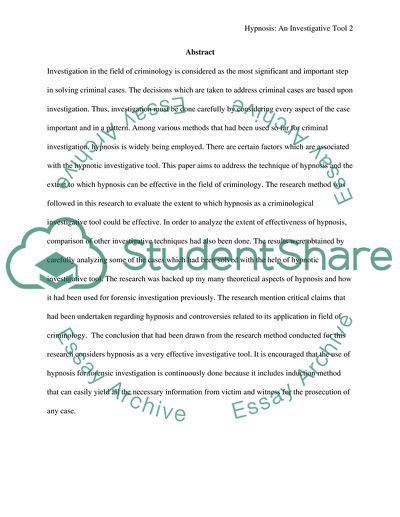Cite this document
(Hypnosis in Criminology Coursework Example | Topics and Well Written Essays - 3750 words, n.d.)
Hypnosis in Criminology Coursework Example | Topics and Well Written Essays - 3750 words. Retrieved from https://studentshare.org/law/1741309-crime-psychology-to-what-extent-is-hypnosis-an-effective-technique-in-gaining-into-the-subconscious-mind-of-a-crime-witness-and-in-accumulating-an-accurate-restoration-of-the-crime-scene
Hypnosis in Criminology Coursework Example | Topics and Well Written Essays - 3750 words. Retrieved from https://studentshare.org/law/1741309-crime-psychology-to-what-extent-is-hypnosis-an-effective-technique-in-gaining-into-the-subconscious-mind-of-a-crime-witness-and-in-accumulating-an-accurate-restoration-of-the-crime-scene
(Hypnosis in Criminology Coursework Example | Topics and Well Written Essays - 3750 Words)
Hypnosis in Criminology Coursework Example | Topics and Well Written Essays - 3750 Words. https://studentshare.org/law/1741309-crime-psychology-to-what-extent-is-hypnosis-an-effective-technique-in-gaining-into-the-subconscious-mind-of-a-crime-witness-and-in-accumulating-an-accurate-restoration-of-the-crime-scene.
Hypnosis in Criminology Coursework Example | Topics and Well Written Essays - 3750 Words. https://studentshare.org/law/1741309-crime-psychology-to-what-extent-is-hypnosis-an-effective-technique-in-gaining-into-the-subconscious-mind-of-a-crime-witness-and-in-accumulating-an-accurate-restoration-of-the-crime-scene.
“Hypnosis in Criminology Coursework Example | Topics and Well Written Essays - 3750 Words”, n.d. https://studentshare.org/law/1741309-crime-psychology-to-what-extent-is-hypnosis-an-effective-technique-in-gaining-into-the-subconscious-mind-of-a-crime-witness-and-in-accumulating-an-accurate-restoration-of-the-crime-scene.


